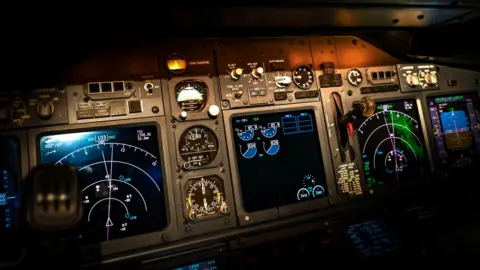Investigators are delving into a perplexing mystery following the crash of Air India Flight 171, which occurred just seconds after takeoff in June, resulting in the tragic loss of 260 lives. Recent findings from the preliminary investigation have emphasized the cockpit audio recordings that complicate the understanding of why the aircraft—a Boeing 787 Dreamliner—lost power due to an abrupt switch to the "cut-off" position on its fuel-control levers.
The cockpit voice recording captures an exchange in which one pilot questions the other about the cut-off switch being engaged, to which the response indicates that the pilot did not execute the action. Unfortunately, the recording does not clarify who initiated the switch, leaving key questions regarding pilot actions unaddressed. Initially, the co-pilot was at the controls while the captain monitored the flight as it attained an altitude of 625 feet before losing vital location data shortly after.
Importantly, both fuel switches are designed to resist accidental activation. Air accident experts have noted that pulling both switches simultaneously would be incredibly challenging. This has led professionals to speculate about whether the action was deliberate or a result of confusion. The former director of the US National Transportation Safety Board, Peter Goelz, expressed concern over the implications of a pilot intentionally shutting down the fuel supply within seconds of takeoff, indicating a deeper issue that is yet to be investigated.
Investigations are also examining the report which detailed a Special Airworthiness Information Bulletin issued by the US Federal Aviation Administration in 2018, warning about potential disengagements of the locking feature of fuel control switches in some Boeing models. Air India, daringly, did not carry out the recommended inspections, which raises further suspicions about the switches involved in the crash. Aviation experts are debating the implications of this advisory, determining whether it may be a red herring or perhaps directly linked to the operational failures.
As the investigation continues, the possibilities surrounding a pilot error, mechanical malfunction, or an unpredicted failure of electronic systems are still heavily scrutinized. Reports indicate that both pilots passed breathalyser tests and had adequate rest; however, the investigation is focused on revisiting cockpit communications throughout the flight. Experts have called for enhanced safety measures, including the recommendation for cockpit video recorders to provide a clearer picture of pilot actions during critical moments leading up to emergencies.
The unfolding inquiry into Air India Flight 171 not only seeks to answer crucial questions about the crash details but also aims to fortify aviation safety measures to prevent similar disasters in the future.





















